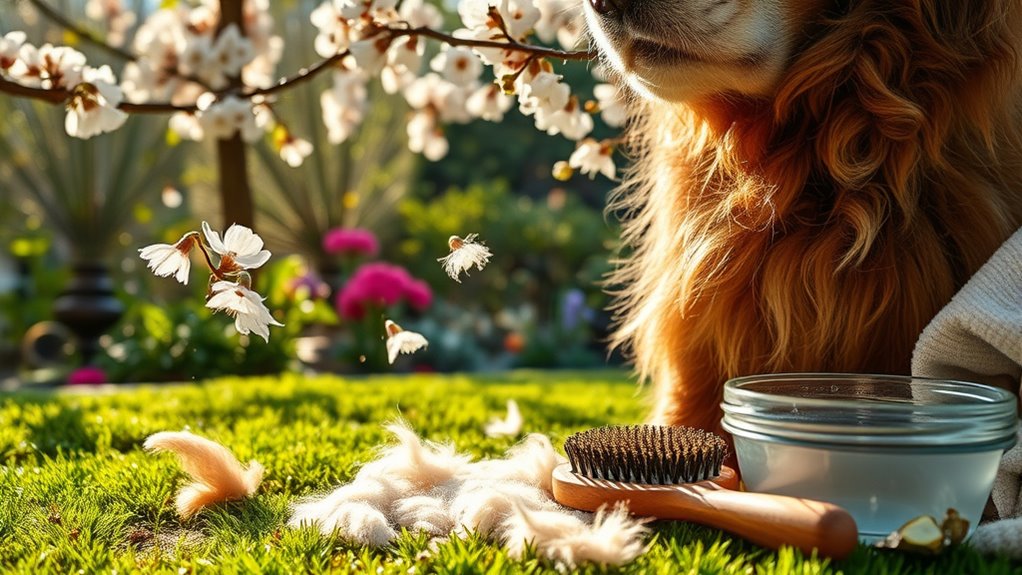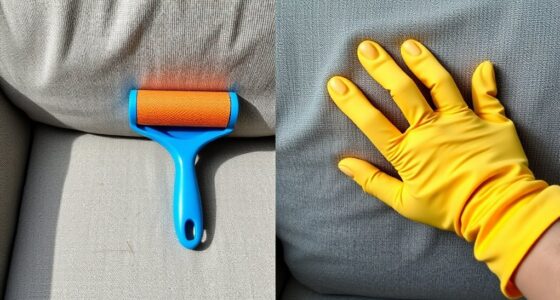To manage seasonal shedding in spring and fall, start by brushing your pet regularly with the right tools to remove loose hair before it falls everywhere. Make sure they get proper nutrition, rich in omega fatty acids, to support a healthy coat, and keep them well-hydrated. Bathe them with shedding-specific shampoos during peak times and watch for any unusual skin issues. Staying consistent with grooming and care can greatly reduce fur around your home; explore more tips for effective control.
Key Takeaways
- Increase regular brushing with suitable tools to remove loose fur before it falls naturally.
- Use shedding-specific shampoos and bathe your pet during peak shedding seasons to loosen dead hair.
- Enhance diet with omega-3 and omega-6 fatty acids to promote healthy skin and reduce excessive shedding.
- Ensure your pet stays well-hydrated to support skin health and minimize dryness that can worsen shedding.
- Monitor shedding patterns and consult a veterinarian if you notice excessive or abnormal hair loss or skin issues.

As the seasons change, many pets naturally shed their coats, leaving fur around your home and on your furniture. This process is normal, but managing the shedding can be challenging. One effective way to reduce excess fur is by adopting proper grooming techniques. Regular brushing helps remove loose hair before it falls off naturally, preventing it from settling on your furniture and floors. For pets with thick or double coats, daily brushing during peak shedding periods can make a noticeable difference. Use the right tools—slicker brushes, undercoat rakes, or grooming gloves—to reach beneath the top layer and extract loose fur efficiently. Not only does this keep shedding under control, but it also stimulates blood flow, promoting healthier coat growth. Additionally, bathing your pet with a gentle, shedding-specific shampoo can loosen dead hair and hydrate the skin, making hair fall out more easily. Just be careful not to over-bathe, as excessive washing can dry out their skin and exacerbate shedding.
Proper nutrition, including essential fatty acids, plays a crucial role in maintaining a healthy coat and minimizing shedding. Alongside grooming, dietary adjustments can play a significant role in managing seasonal shedding. A balanced diet rich in essential fatty acids, such as omega-3 and omega-6, supports skin health and coat quality. These nutrients help reduce dryness and itchiness, which can stimulate excessive shedding as your pet scratches or bites at their fur. Consider adding high-quality fish oil supplements or incorporating fatty fish like salmon into their meals, but consult your veterinarian first to determine the appropriate dosage. Proper nutrition not only improves coat condition but also boosts your pet’s immune system, helping them handle seasonal changes more effectively. Ensuring your pet stays well-hydrated is equally important, as dehydration can lead to dry skin and increased shedding. Fresh water should always be available, especially during warmer months when dehydration risks rise.
Combining grooming techniques with dietary adjustments creates an all-encompassing approach to managing seasonal shedding. Regular, thorough brushing reduces loose fur around your home, while a nutritious diet supports healthier, shinier coats. Remember, shedding is a natural part of your pet’s seasonal cycle, but with consistent care, you can keep it under control. Pay attention to your pet’s specific needs—some breeds shed more than others—and adapt your grooming routine accordingly. If shedding seems excessive or is accompanied by skin irritation or bald patches, consult your veterinarian to rule out underlying health issues. By taking proactive steps, you’ll help your pet stay comfortable and your home cleaner, making seasonal transitions smoother for everyone involved.
Frequently Asked Questions
How Can I Tell if Shedding Is Excessive or Normal?
You can tell if shedding is excessive by observing if you’re losing more hair than usual, especially during seasonal changes. If you notice significant hair loss, thinning patches, or hair coming out easily, it might be a sign of abnormal shedding. Keep an eye on your skin health; dull or flaky skin can also indicate underlying issues. If concerns persist, consult a dermatologist to assess underlying causes and make certain your hair loss isn’t a sign of a health problem.
Are Specific Breeds More Prone to Seasonal Shedding?
Yes, certain breeds are more prone to seasonal shedding due to breed tendencies and shedding cycles. For example, double-coated breeds like Huskies and Golden Retrievers shed more heavily during spring and fall, as their coat adjusts to temperature changes. On the other hand, breeds like Poodles and Bichon Frises shed minimally year-round. Understanding your dog’s breed tendencies helps you anticipate and manage seasonal shedding effectively.
Can Diet Changes Reduce Shedding During Spring and Fall?
Yes, diet changes can help reduce shedding during spring and fall. Studies show that over 60% of pet owners notice less hair loss when they make dietary adjustments. You should consider adding nutritional supplements like omega-3 fatty acids and ensuring a balanced diet rich in vitamins. These dietary adjustments strengthen your pet’s coat and skin, promoting healthier shedding and less hair around your home.
What Are Safe Grooming Practices During Heavy Shedding?
During heavy shedding, you should use gentle brushing techniques with appropriate grooming tools like slicker brushes or de-shedding tools. Brush your pet regularly to remove loose fur and prevent matting. Be gentle around sensitive areas and avoid over-brushing, which can cause skin irritation. Keep grooming sessions short and positive, and if your pet shows signs of discomfort, stop and consult a vet or professional groomer for advice.
When Should I Consult a Veterinarian About Shedding Concerns?
You should consult a veterinarian if your pet’s shedding seems excessive or persists beyond normal seasonal changes. Watch for breed-specific issues that may cause abnormal shedding, or environmental triggers like stress, diet, or allergies. If you notice bald spots, skin irritation, or unusual hair loss, it’s time to seek professional advice, ensuring your pet stays healthy and comfortable during heavy shedding seasons.
Conclusion
As you tackle seasonal shedding, you’ll notice that your pet’s coat naturally responds to the changing temperatures—almost like it’s synchronized with the seasons. By maintaining a consistent grooming routine and providing proper nutrition, you help your furry friend adapt more comfortably. Sometimes, it feels like nature itself is helping you out, shedding just enough to prepare your pet for the new season. Embrace these moments—they remind you that caring for your pet is a true partnership with the seasons.









